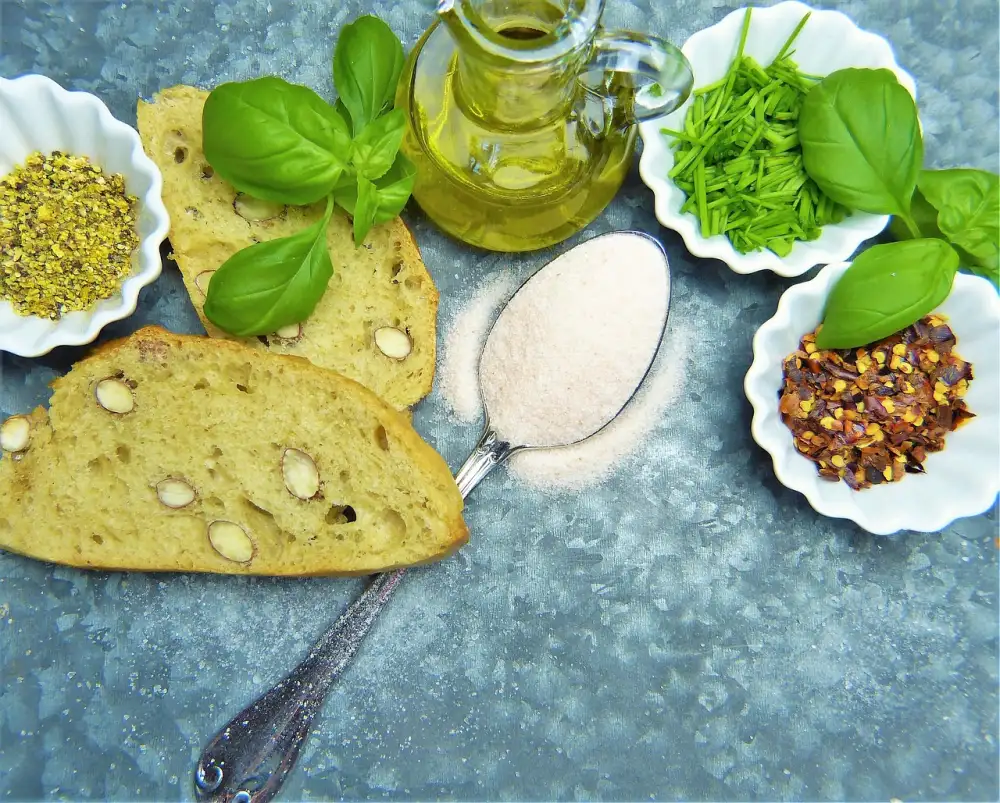Unlocking the Secrets of Gluten Free Flour: A Healthier Alternative for Wheat-Free Baking

- Understanding Gluten and its Effects on Health
- What is Gluten-Free Flour?
- Benefits of Using Gluten-Free Flour
- Types of Gluten-Free Flours Available
- How to Use Gluten-Free Flour in Cooking and Baking
- Tips for Successfully Substituting Gluten-Free Flour
- Potential Challenges and Solutions when Using Gluten-Free Flour
- Gluten-Free Flour Recipes for Healthier Alternatives
In recent years, there has been a growing interest in gluten-free diets due to the rise in gluten-related health issues and the increasing number of people with gluten sensitivities or celiac disease. As a result, the demand for gluten-free alternatives has skyrocketed, leading to the development of various gluten-free products, including gluten-free flour.
Gluten is a protein found in wheat, barley, and rye that gives dough its elasticity and helps it rise. However, for those who cannot tolerate gluten, consuming foods containing this protein can lead to digestive discomfort and other health problems.
Gluten-free flour provides a healthier alternative for individuals who need to avoid gluten. It allows them to enjoy their favorite baked goods without sacrificing taste or texture. This versatile ingredient opens up a world of possibilities for those following a gluten-free lifestyle.
In this article, we will explore the secrets of gluten-free flour, its benefits, different types available in the market, and how to successfully incorporate it into your cooking and baking endeavors. Whether you have dietary restrictions or simply want to explore new culinary horizons, unlocking the potential of gluten-free flour is sure to enhance your kitchen skills and broaden your culinary repertoire.
Understanding Gluten and its Effects on Health
Gluten is a protein found in wheat, barley, and rye. For individuals with celiac disease or gluten sensitivity, consuming gluten can lead to various health issues. Celiac disease is an autoimmune disorder where the ingestion of gluten causes damage to the small intestine, leading to malabsorption of nutrients. Symptoms include abdominal pain, bloating, diarrhea, and fatigue.
Gluten sensitivity, also known as non-celiac gluten sensitivity, is a condition where individuals experience similar symptoms to celiac disease but do not have the same intestinal damage. These symptoms can range from mild discomfort to severe digestive issues.
In addition to gastrointestinal problems, gluten consumption has been linked to other health conditions such as dermatitis herpetiformis (a skin rash), joint pain, headaches, and mental fog. By eliminating gluten from their diet and opting for gluten-free alternatives like gluten-free flour, individuals can alleviate these symptoms and improve their overall well-being.
What is Gluten-Free Flour?
Gluten-free flour is a type of flour that does not contain gluten, a protein found in wheat, barley, and rye. It is specially made for individuals with celiac disease or gluten sensitivity who need to avoid gluten in their diet. Gluten-free flour can be made from a variety of grains and starches such as rice, corn, potato, tapioca, and sorghum. These alternative flours provide a similar texture and taste to traditional wheat flour but without the harmful effects of gluten on health.
Benefits of Using Gluten-Free Flour
Using gluten-free flour in your cooking and baking can offer a range of benefits. Firstly, it provides a healthier alternative for those with gluten sensitivities or celiac disease, allowing them to enjoy their favorite foods without the negative health effects. Additionally, gluten-free flour is often higher in fiber and nutrients compared to traditional wheat flour, making it a more nutritious choice. It can also add variety to your diet, as there are numerous types of gluten-free flours available, each with its own unique flavor profile. Lastly, using gluten-free flour opens up possibilities for experimenting with new recipes and creating delicious dishes that cater to different dietary needs.
Types of Gluten-Free Flours Available
There are several types of gluten-free flours available on the market today, each with its own unique properties and flavors. Some popular options include almond flour, coconut flour, rice flour, tapioca flour, and sorghum flour. Almond flour is made from ground almonds and adds a nutty flavor to baked goods. Coconut flour is made from dried coconut meat and has a slightly sweet taste. Rice flour is made from finely milled rice grains and has a neutral flavor. Tapioca flour, also known as tapioca starch, is derived from the cassava root and adds a chewy texture to recipes. Sorghum flour is made from ground sorghum grains and has a mild taste similar to wheat flour. These gluten-free flours can be used individually or combined in various ratios to achieve desired textures and flavors in gluten-free baking.
How to Use Gluten-Free Flour in Cooking and Baking
When using gluten-free flour in cooking and baking, it's important to understand its unique properties. Gluten-free flours tend to be denser and have less elasticity compared to wheat flour. To achieve the best results, it's recommended to blend different types of gluten-free flours together. This helps create a more balanced texture and flavor. Additionally, adding binders such as xanthan gum or guar gum can help improve the structure of baked goods. It's also essential to follow recipes specifically designed for gluten-free baking, as they often require adjustments in liquid ratios and baking times. With practice and experimentation, you'll discover the versatility of gluten-free flour and be able to create delicious dishes that cater to various dietary needs.
Tips for Successfully Substituting Gluten-Free Flour
When substituting gluten-free flour in your recipes, it's important to keep a few tips in mind for successful results. Firstly, always use a blend of gluten-free flours rather than relying on just one type. This will help achieve a better texture and taste. Secondly, add xanthan gum or guar gum to your recipes as they act as binders and thickeners, mimicking the effects of gluten. Thirdly, increase the liquid content slightly to compensate for the absorbency of gluten-free flours. Lastly, be patient and experiment with different ratios and techniques until you find what works best for each recipe.
Potential Challenges and Solutions when Using Gluten-Free Flour
While gluten-free flour offers a healthier alternative for those with wheat sensitivities or celiac disease, it does come with its own set of challenges. One common challenge is that gluten-free flours tend to have a denser texture, which can affect the overall taste and texture of baked goods. To overcome this, it is important to use a combination of different gluten-free flours to achieve the desired consistency.
Another challenge is that gluten-free flours often lack the binding properties that wheat flour provides. This can result in baked goods that crumble easily. To solve this issue, adding xanthan gum or guar gum to the recipe can help improve the binding properties and create a more cohesive texture.
Additionally, gluten-free flours may require more liquid than traditional wheat flour recipes. It is important to adjust the amount of liquid accordingly to prevent dry and crumbly results. Experimenting with different ratios of liquid can help achieve the desired consistency.
Lastly, it's worth noting that gluten-free flours have a shorter shelf life compared to wheat flour. They tend to go rancid faster due to their higher fat content. Storing them in an airtight container in the refrigerator or freezer can help prolong their freshness.
By being aware of these potential challenges and implementing these solutions, you can successfully navigate the world of gluten-free baking and enjoy delicious treats without compromising on taste or texture.
Gluten-Free Flour Recipes for Healthier Alternatives
1. Gluten-Free Banana Bread: Replace regular flour with gluten-free flour in your favorite banana bread recipe for a moist and delicious treat.
2. Gluten-Free Pancakes: Whip up a batch of fluffy gluten-free pancakes using a blend of gluten-free flours like rice flour, almond flour, and tapioca starch.
3. Gluten-Free Chocolate Chip Cookies: Enjoy the classic taste of chocolate chip cookies by using a combination of gluten-free flours such as sorghum flour, brown rice flour, and potato starch.
4. Gluten-Free Pizza Crust: Create a crispy gluten-free pizza crust by mixing together gluten-free flours like white rice flour, tapioca starch, and xanthan gum.
5. Gluten-Free Blueberry Muffins: Indulge in moist and flavorful blueberry muffins made with a mix of gluten-free flours like oat flour, almond flour, and quinoa flour.
These recipes showcase the versatility of gluten-free flour and prove that you don't have to sacrifice taste or texture when opting for healthier alternatives.
In conclusion, embracing the versatility of gluten-free flour opens up a world of possibilities for those with dietary restrictions or health concerns. Whether you are looking to bake bread, make pancakes, or create delicious desserts, gluten-free flour can be a healthier alternative that doesn't compromise on taste or texture. With the variety of options available, from almond flour to rice flour, there is a gluten-free flour suitable for every recipe. So why not give it a try and unlock the secrets of gluten-free baking? Your taste buds and your health will thank you!
Published: 12. 12. 2023
Category: Health



